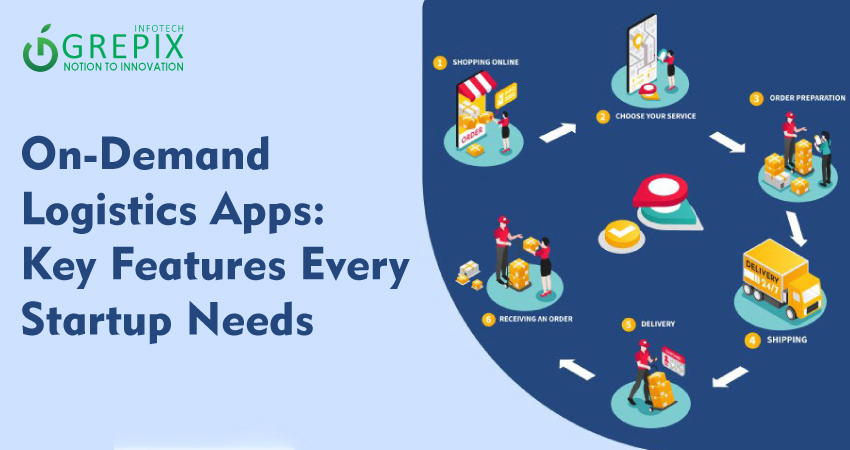On-Demand Logistics Apps: Key Features Every Startup Needs
The surge in e-commerce, evolving consumer expectations, and the gig economy have made on-demand logistics apps indispensable. Whether powering a courier clone app, scaling a local delivery network, or optimizing a complex supply chain, the right delivery management software transforms business outcomes.
Launching an on-demand logistics app sets the foundation for rapid, reliable deliveries in today's ultra-competitive market. Platforms like courier clone app and advanced delivery management software empower startups with real-time tracking, proof of delivery, and intelligent route optimization. These features not only delight customers but also reduce operational costs and errors. Understanding the true value of real-time data, seamless integration, and user-focused design is vital. This comprehensive guide explores essential app features, backed by global trends, proven case studies, and actionable statistics. With mobile-first delivery management software now the industry standard, startups can't afford to lag behind. Discover the blueprint for a successful logistics tech launch and set your business on the fast track.
Key Features Every Logistics Startup Needs
Real-Time Tracking (Primary Keyword Usage)
Every leading on-demand logistics app or courier clone app offers real-time GPS tracking. This empowers both customers and businesses with instant visibility on delivery status. According to a 2024 industry report, 85% of consumers are more likely to choose a provider offering up-to-the-minute tracking updates.
Benefits:
- Reduces “where's my order?” calls
- Builds trust through transparency
- Enables proactive management of exceptions
Example:
Uber Freight and DoorDash offer customers a live map and minute-by-minute ETAs, setting delivery expectations and improving satisfaction levels.
Proof of Delivery
Modern delivery management software ensures that each handoff is verified. Proof of delivery (POD) can include customer signatures, time-stamped photos, or barcode scans.
Types of POD:
- Digital signatures within courier clone apps
- Photo capture for no-contact drop-offs
- Barcode/QR scan when handing over high-value items
Case Study:
A European grocery startup reduced delivery disputes by 30% after mandating photo-based proof in their on-demand logistics app.
Route Optimization
Route optimization is the profit driver. Advanced courier clone app solutions use AI and real-time data to slash delivery times and fuel costs.
Why It Matters:
- Reduces mileage and operational costs by up to 25%
- Handles changing traffic or last-minute orders
- Increases capacity deliver more with less
Real Example:
DHL’s use of dynamic route suggestions helped their drivers complete 15% more deliveries per shift, saving millions annually.
More Essential Features (Delivery Management Software Section)
Automated Dispatch & Load Matching
Automated dispatch via intelligent algorithms matches jobs to the right driver, factoring in proximity, capacity, and vehicle type. This boosts efficiency while keeping drivers active and earning.
Must-Have in Your App:
- One-tap driver assignment for admins
- Instant job notifications in the courier clone app
- Manual override for high-priority or urgent deliveries
Driver & Fleet Management
A powerful on-demand logistics app comes with rich features for fleet monitoring:
- Driver availability tracking
- Real-time vehicle health updates
- Centralized compliance records for licensing, insurance, and hours worked
- Built-in driver rating and feedback systems
Startups that prioritize driver experience and safety see improved retention and reliability.
Customer-Facing Features
Impressive delivery management software delights customers with:
- Customized push notifications for every delivery milestone
- Secure online payment options and cash-on-delivery toggles
- One-click reordering or scheduled deliveries
- Two-way messaging with drivers
A 2025 Gartner survey found that businesses with interactive tracking and real-time support saw 40% higher repeat purchase rates.
Robust Admin Panel
A courier clone app’s behind-the-scenes “control tower” is the admin panel. Must-have features include:
- Real-time fleet status maps
- Automated and manual dispatch controls
- Granular analytics and downloadable reports
- Geo-fencing alerts to monitor specific zones
Security and Compliance
With sensitive customer data and high-value shipments, delivery management software must provide:
- Multi-factor authentication for all users
- End-to-end encryption
- Automated document and invoice handling
- GDPR and payment regulations, especially for cross-border operations
In-Depth Look: Real-Life Statistics and Trends
- 67% of consumers expect real-time visibility for shipping, up from 36% in 2021 (Statista, 2024)
- Businesses using optimized route planning report up to 30% improved delivery speed and up to 20% lower fuel costs
- Automated proof of delivery reduces insurance disputes by up to 40%
- Global logistics apps market is projected to grow 12% annually to $6.5bn by 2027 (Allied Market Research, 2025)
Also Read: "Cloud Kitchens and Food Delivery Apps: A Perfect Match"
Case Study: Local Delivery Startup Success
- ParcelPro, a regional courier startup, adopted a no-code courier clone app in 2025. Key results:
- Reduced customer support tickets by 45% due to live tracking
- Route optimization features improved daily deliveries from 60 to 90 with the same fleet
- Scalable delivery management software enabled expansion from 1 to 4 cities in 12 months
Building the Right Logistics App: Step-by-Step
- Define business goals (urban, regional, global)
- Map out target users’ pain points
- Prioritize must-have app features (use this guide)
- Select an experienced tech partner with proven courier clone app experience
- Plan for integrations with payment gateways, ERP, or IoT devices
- Test with real drivers and customers for usability
- Launch, gather feedback, and iterate
Top Tech Stacks for On-Demand Logistics Apps
- Cloud backend: AWS, Azure, Google Cloud
- Mobile front-end: Flutter, React Native
- Real-time tracking: Google Maps/Mapbox APIs
- Payment solutions: Stripe, Razorpay
- Notifications: Firebase, Twilio
Conclusion
Embracing a robust on-demand logistics app is no longer optional it’s the standard for any courier, e-commerce, or retail startup eager to thrive in today’s instant-delivery economy. By equipping a courier clone app or delivery management software with core features like real-time tracking, proof of delivery, and route optimization, companies eliminate inefficiencies, boost margins, and deliver experiences that foster loyalty.
Global trends favor platforms that automate, inform, and adapt now's the moment for startups to build, innovate, and dominate. Ready to bring your delivery tech dreams to life? Choose the right partner, focus on core features, and set your business apart. Share this guide if you found it helpful, and take your logistics startup from launch to leadership
FAQs
1. What are the must-have features in an on-demand logistics ap
Real-time tracking, proof of delivery, route optimization, automated dispatch, driver management, push notifications, secure payments, and robust admin controls.
2. How does a courier clone app differ from custom delivery software?
A courier clone app offers ready-made workflows and features, ideal for startups launching quickly, while custom delivery management software is tailored for unique or large-scale needs.
3. How does real-time tracking benefit businesses and customers?
It provides transparency, reduces support calls, and empowers proactive decision-making, leading to higher customer satisfaction.
4. What industries use delivery management software?
E-commerce, food & grocery, healthcare, manufacturing, retail, and field service companies all leverage these solutions.
5. How does route optimization impact ROI?
Route optimization lowers costs, increases completed orders, and improves driver satisfaction; businesses save 15–30% annually on delivery costs.







